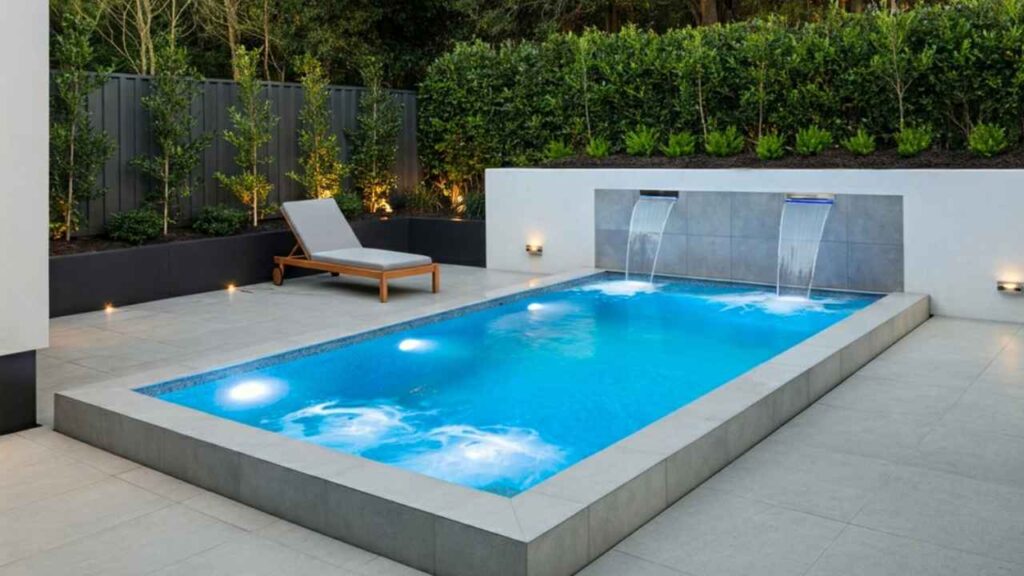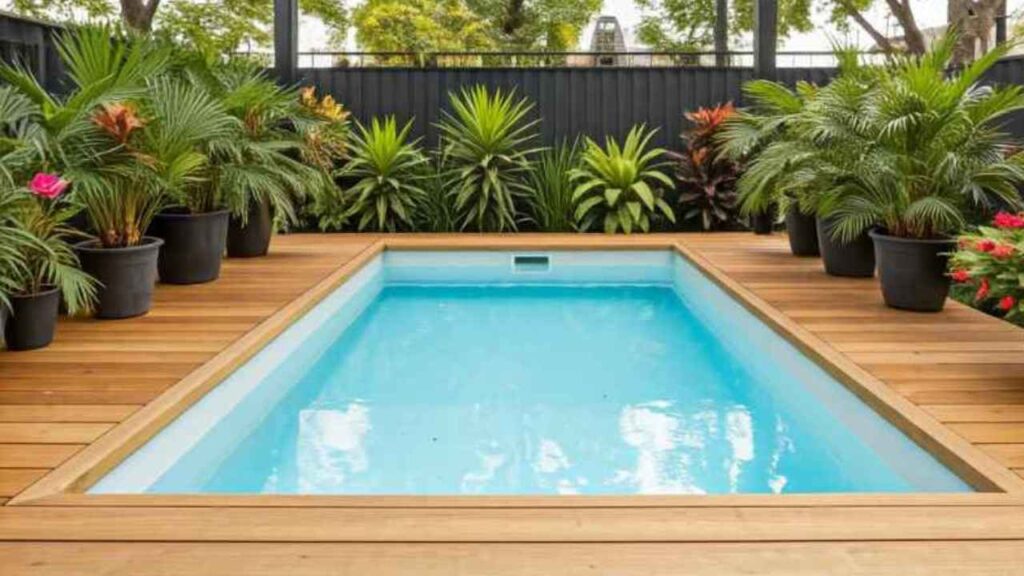At Plunge Pools Adelaide, we provide high-quality plunge pool installations and services. With years of experience, we offer practical advice to help local homeowners maintain their pools effectively.
This guide explains how to care for your plunge pool. Learn about water chemistry, eco-friendly methods, and solutions for common problems. These steps will keep your pool clean and safe for regular use.

Table of Contents
ToggleThe Basics of Plunge Pool Hygiene
1. Understanding Water Chemistry
Balanced water chemistry is essential for keeping your pool safe and clean. Imbalances can cause cloudy water, skin irritation, and damage to pool surfaces.
- pH Levels: Maintain a pH between 7.2 and 7.8 to ensure good water quality that is safe and comfortable for swimming.
- Chlorine Levels: Keep free chlorine at 1–3 ppm to kill bacteria and algae.
- Alkalinity: Ensure alkalinity levels stay between 80–120 ppm to stabilise pH and prevent fluctuations.
2. Essential Cleaning Tools for Every Pool Owner
The right tools simplify pool maintenance and ensure better results.
- Pool Skimmer: Use daily to remove leaves and debris from the surface.
- Pool Brush: Brush walls weekly to prevent algae buildup.
- Vacuum: Clean the floor with a manual or robotic vacuum to remove dirt.
Innovative Upgrade: Use a robotic pool cleaner or automatic chlorinator to save time. These tools provide consistent cleaning and water treatment with minimal effort.
Eco-Friendly and Sustainable Pool Maintenance
1. Eco-Friendly Cleaning Alternatives
You can maintain a clean plunge pool without using harsh chemicals. Eco-friendly methods are safer for your family and better for the environment.
- Natural Cleaning Agents: Scrub stains with baking soda and clean edges with white vinegar. These options are effective and gentle on surfaces.
- Biodegradable Chemicals: Choose pool cleaning products that break down naturally to keep the water clean and free from harmful chemicals, while protecting the environment.
2. Water Conservation Tips
Conserving water is an essential part of responsible pool care.
- Optimise Filtration: Run your filtration system daily to reduce water changes. Circulation prevents stagnation and keeps the pool fresh.
- Recycle Backwashed Water: Use backwashed water for landscaping. Many plants can handle this type of water, reducing waste.
3. Solar Pool Covers and Energy-Efficient Equipment
Solar pool covers and efficient equipment can save energy and make pool care easier.
- Reduces Evaporation: A solar cover minimises water loss, especially in Adelaide’s hot climate.
- Maintains Temperature: Heated plunge pools stay warm longer with a solar cover, cutting energy costs.
- Prevents Debris: A pool cover blocks leaves and dust when the pool is not in use.
By adopting these eco-friendly practices, you can reduce costs, conserve resources, and ensure your plunge pool stays cleaner and healthier for longer.
Step-by-Step Maintenance Plans
Consistency is essential to keep your plunge pool clean and in top shape. Follow these simple daily, weekly, and monthly routines to maintain a perfect pool year-round.
1. Daily Maintenance Routine
- Skim the Surface: Use a skimmer net daily to remove leaves, insects, and debris. This keeps water clear and prevents clogs in the filter.
- Check Water Levels: Ensure the water is at the midpoint of the skimmer opening to prevent pump strain.
- Run the Pump: Operate the filtration system for 6–8 hours daily to circulate water and remove impurities.
Quick Tip: Keep a printed daily maintenance checklist near your pool equipment for quick reminders.
2. Weekly Maintenance Routine
- Brush and Vacuum: Brush walls and floors to prevent algae growth, and vacuum the pool to remove dirt and debris. Robotic vacuums can save time.
- Test Water Chemistry: Use a kit to check pH, chlorine, and alkalinity levels. Adjust with pool-safe chemicals to maintain balance.
- Clean the Filter: Rinse or backwash your filter weekly to ensure it works efficiently.
3. Monthly Maintenance Routine
- Deep Clean Surfaces: Scrub areas prone to scaling or residue and inspect for damage.
- Shock the Pool: Perform a shock treatment to remove bacteria, algae, and other contaminants after heavy use or rain.
- Inspect Equipment: Check pumps, filters, and other components for wear and tear. Replace damaged parts to avoid costly repairs.
These routines ensure a clean, safe plunge pool with minimal effort, so you can enjoy it all year round.
Personalised Maintenance Tips by Pool Type
Different types of plunge pools need specific care. Follow these tips for saltwater, cold, and heated plunge pools to keep them clean and functional.
1. Saltwater Pools
Saltwater pools are known for their softer water and reduced chemical use.
- Monitor Salt Levels: Use a test kit to keep salt levels between 2,500 and 3,500 ppm. Low salt affects chlorine production, while high salt damages equipment.
- Clean the Salt Cell: Inspect and clean the salt chlorinator cell every month to prevent scaling.
- Prevent Corrosion: Avoid metal accessories and rinse ladders or fixtures exposed to saltwater.
2. Cold Plunge Pools
Cold plunge pools require regular care to maintain hygiene and water clarity.
- Use UV Sterilisers or Ozone Purifiers: These systems kill bacteria without relying on chlorine, keeping water clean and safe.
- Prevent Contamination: Rinse off before plunging to reduce dirt and oils in the water.
- Keep the Water Temperature Low: Ensure the chiller is working correctly, as cold water slows algae and bacteria growth.
3. Heated Plunge Pools
Heated pools create a relaxing environment but need extra care to handle heat-related issues.
- Prevent Scale Buildup: Use a scale inhibitor to reduce mineral deposits from heated water.
- Optimise Filtration: Run the filtration system longer to manage additional contaminants caused by warm water.
- Cover When Not in Use: Use an insulated cover to retain heat and keep debris out.
Tailoring maintenance to your pool type helps address specific challenges and extends the life of your plunge pool.
Troubleshooting Common Plunge Pool Issues
Even with regular maintenance, plunge pools can develop issues. Follow these steps to address common problems quickly and effectively.
1. Cloudy Water
Causes:
- Poor filtration or water circulation.
- Imbalanced water chemistry, such as high pH or low chlorine.
- Contaminants from heavy use.
Solutions:
- Test and adjust pH, alkalinity, and chlorine levels to restore balance.
- Backwash or clean the filter to improve water flow.
- Use a pool clarifier to bind fine particles for easier filtration.
2. Persistent Algae Growth
Causes:
- Low chlorine or insufficient circulation.
- Warm water or accumulated debris.
Solutions:
- Increase chlorine levels or shock the pool to eliminate algae.
- Brush walls and vacuum thoroughly to remove algae deposits.
- Use phosphate removers to limit algae growth if it reoccurs.
3. Odours and Slimy Surfaces
Causes:
- Organic material build-up, such as oils or sweat.
- Inadequate sanitisation or poor circulation.
Solutions:
- Shock the pool to eliminate organic contaminants.
- Scrub slimy surfaces and clean the filter and skimmer.
- Use enzyme treatments to break down oils and other residues.
4. Leaks and Equipment Failures
Causes:
- Cracks in the pool structure or worn-out seals.
- Excessive wear on pumps, filters, or other components.
Solutions:
- Perform a bucket test to confirm a leak: compare water loss in the pool and a bucket over 24 hours.
- Inspect and tighten equipment connections or replace damaged seals.

Long-Term Care and Pool Longevity Tips
A long-term care plan keeps your plunge pool clean and extends its lifespan. Use these strategies to maintain your pool for years.
1. Protecting Pool Liners and Surfaces
- Avoid Abrasive Tools: Clean with soft-bristle brushes or pool-safe scrubbing pads to prevent scratches or damage.
- Apply UV-Resistant Coatings: Use UV-resistant coatings to shield pool liners from sun damage, especially during Adelaide’s hot summers.
- Prevent Scale and Stains: Test calcium hardness regularly and use stain removers or sequestrants to stop mineral buildup.
2. Chemical Storage and Safety
- Store Chemicals Properly: Keep chemicals in a cool, dry, ventilated area away from sunlight to preserve effectiveness.
- Label and Secure Containers: Ensure containers are clearly labelled and stored out of children’s and pets’ reach.
- Follow Usage Guidelines: Measure chemicals accurately and avoid mixing products to prevent hazards.
3. Seasonal Maintenance Tips
Winterising Your Pool:
- Lower the water level to avoid freezing damage if temperatures drop significantly.
- Use a winter cover to block debris.
- Run the pump occasionally to maintain circulation.
Preparing for Summer:
- Inspect equipment and replace worn-out parts.
- Shock the pool and test water chemistry to ensure safety.
- Clean the pool thoroughly, including brushing and vacuuming.
Conclusion
Caring for your plunge pool is simple with regular maintenance, eco-friendly practices, and seasonal adjustments. These steps keep your pool clean, safe, and long-lasting.
For expert advice or installation services, contact Plunge Pools Adelaide. We specialise in installing high-quality plunge pools for your backyard. We also offer valuable tips and guidance to help you maintain your pool with ease. Contact us today to start you dream plunge pool.
What’s Next To Do?
Missed our last post? Be sure to check out our previous article on Plunge Pools Pros and Cons to help you weigh the benefits and considerations of owning one.
Looking ahead, don’t miss our next article: Is a Plunge Pool Worth the Investment? We’ll explore the costs, benefits, and whether it’s the right choice for your home.
Frequently Asked Questions
1. How often should I clean my plunge pool?
Skim debris and check water levels daily. Brush walls, vacuum, and test water chemistry weekly. Perform monthly deep cleaning, including filter maintenance. Consistent care prevents algae and cloudy water, keeping your pool ready for use.
2. How to prevent cloudy water in a plunge pool?
Balance pH (7.2–7.8) and chlorine (1–3 ppm). Run the pump 6–8 hours daily for circulation, clean filters regularly, and avoid contaminants like oils. Shock the pool monthly to clear impurities.
3. How to keep a small plunge pool free of algae?
Maintain stable chlorine levels, brush walls weekly, and ensure proper filtration. Shock the pool to remove algae if needed. Use algaecides or phosphate removers to prevent algae growth.
4. How to maintain water balance in saltwater plunge pools?
Test weekly for pH (7.2–7.8), alkalinity (80–120 ppm), and salt (2,500–3,500 ppm). Clean the salt chlorinator cell monthly. Use scale inhibitors and maintain good circulation for even chemical distribution.
5. How to clean your plunge pool after winter?
Remove the cover, skim debris, and brush walls. Shock the pool and balance water chemistry. Clean or replace the filter and inspect equipment for damage before using the pool.




